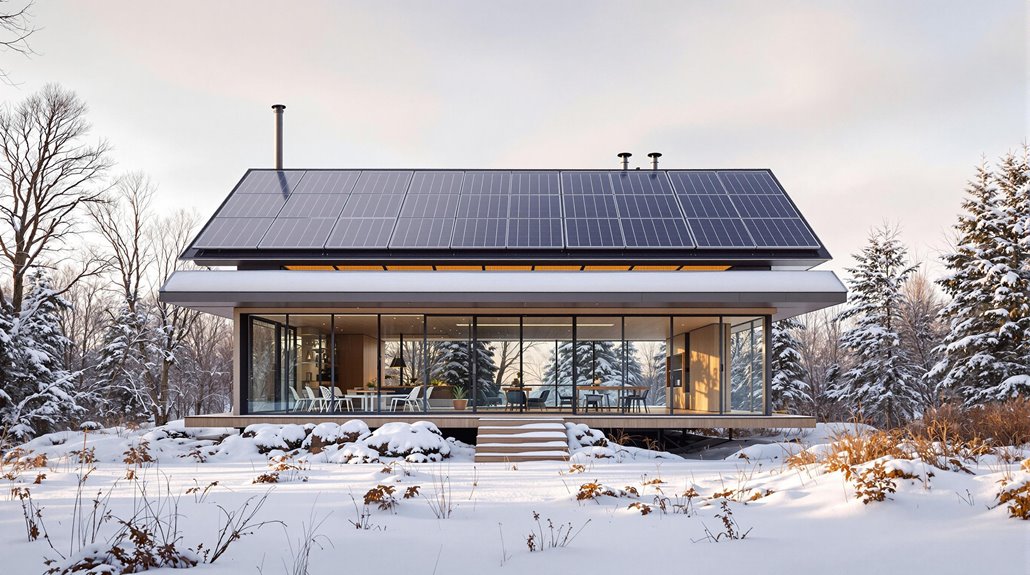Maria Telkes’ “Sun House”: The Day Solar Power Saved a Frozen Family
Imagine waking up on a frigid New England morning in 1948, with no conventional heating system to warm your home. That's exactly what the Nemethy family faced when they agreed to live in Maria Telkes' experimental "Sun House" in Dover, Massachusetts. You'd think they were taking an enormous risk, but Telkes' revolutionary solar heating system, powered by Glauber's salt, proved them right. What unfolded that winter would change our understanding of solar energy's potential and launch a new era in sustainable living.
The Birth of a Solar Pioneer

While many pioneers of solar energy emerged in the 20th century, few matched the innovative spirit of Maria Telkes.
Her early influences rooted in Budapest, Hungary, where she was born in 1900 and developed her passion for science. Her fascination with chemistry began when she created her own chemistry set at age 10.
Her academic achievements began to shine when she earned her doctorate in physical chemistry from the University of Budapest in 1924.
When you look at her journey to America in 1925, you'll see how quickly she established herself as a promising scientist at the Cleveland Clinic Foundation.
She'd later join Westinghouse Electric in 1937, the same year she became a U.S. citizen.
Her remarkable shift from biophysicist to solar energy innovator started taking shape at MIT in 1939, where she began her groundbreaking research on thermoelectric devices. Her unwavering dedication led her to become one of the few women in engineering at MIT during that era.
The Groundbreaking Dover Sun House Vision
As the winter of 1948 approached, Maria Telkes and architect Eleanor Raymond revealed their revolutionary Dover Sun House, marking a pivotal moment in solar energy history.
Their sustainable architecture featured a distinctive wedge-shaped design with 18 south-facing windows, maximizing solar collection potential.
You'd have been amazed by the innovative heating system that set this $20,000 home apart.
At its core, 21 tons of Glauber's salt stored within insulated wall bins provided heat storage seven times more efficient than water.
This solar innovation could maintain warmth through 10 sunless days, using flat-plate air heaters to capture and distribute heat throughout the house.
The project, funded by sculptor Amelia Peabody, transformed a simple Massachusetts home into the world's first modern dwelling heated entirely by solar power. Unfortunately, the system faced efficiency issues and was eventually replaced with oil in 1954.
The Nemethy family lived in and tested this groundbreaking solar-powered residence, providing valuable insights into the practical applications of solar heating technology.
Engineering Marvel: How the Solar System Worked
The ingenious solar heating system at the Dover Sun House operated through an elegant interplay of collection, storage, and distribution components.
You'd find an expansive 800-square-foot glass wall facing south, where sunlight penetrated double-layered panels to warm the air against a black metal backdrop.
The heart of this solar technology lay in its innovative heat storage system using Glauber's salt.
When sunlight warmed the air, fans would circulate it to bins containing metal drums filled with this remarkable salt. As it melted, the salt absorbed heat, later releasing it through recrystallization during sunless periods.
You could rely on this stored warmth for up to three days without sun.
This groundbreaking project was brought to life through the collaboration of architect Eleanor Raymond in 1948.
The system's distribution network then channeled this heat through ducts to maintain comfortable temperatures throughout the living spaces.
The house gained widespread recognition and became one of the most famous residences in America during its time.
Living in Tomorrow's Home: The Nemethy Family Experience
In winter 1948, Dr. Anthony Nemethy moved his family into the Dover Sun House, not realizing they'd become part of a groundbreaking experiment in solar living. For a modest rent, they agreed to showcase their new 800-square-foot home to curious visitors, fundamentally altering their family dynamics.
You can imagine the unique challenges of residing in tomorrow's home. The Nemethys adapted to life behind large windows and learned to manage heat retention by drawing shades at night. The innovative thermal heating system designed by physicist Mária Telkes kept them warm throughout the winter months. The system successfully provided heat for two and a half winters before encountering problems.
Every Wednesday and Sunday, they'd transform their private space into a public exhibition, welcoming over 3,000 visitors in the first year alone. While the media celebrated this "house of the day after tomorrow," the family navigated public perception like modern-day astronauts, balancing their role as both residents and demonstrators of solar innovation.
When Winter Put Solar Power to the Test

Despite solar panels performing more efficiently in cold temperatures, winter's shorter days and reduced sunlight posed considerable challenges for the Dover Sun House.
You'd find that while panels operate best at 40-55°F, the reduced daylight hours and lower sun angles meant considerably less energy generation during winter months.
Solar panels experience efficiency drops of 0.05% per degree above 25°C, making winter temperatures ideal for performance.
Solar panel performance typically drops to about 65% efficiency in winter compared to summer peaks, and you'll see 40-60% less energy production in December and January.
 Cold-climate states have seen substantial savings from solar power installations despite seasonal challenges.
Cold-climate states have seen substantial savings from solar power installations despite seasonal challenges.
These modern solutions help you maximize winter efficiency, though seasonal variations remain an unavoidable reality of solar power.
Legacy of the Sun Queen's Revolutionary Design
Maria Telkes' pioneering work as "The Sun Queen" left an indelible mark on solar energy development that extends far beyond her groundbreaking Dover Sun House.
Her solar innovation legacy lives on in modern energy storage systems, particularly through her revolutionary use of phase-change materials. You'll find her influence in today's sustainable design practices, from solar-heated homes to desalination plants in the US Virgin Islands. Her remarkable four-dollar solar stove demonstrated her commitment to creating affordable, accessible solar solutions for developing nations. After graduating from the University of Budapest, she brought her passion for solar energy research to America in 1925.
Despite initial skepticism about the Dover Sun House's effectiveness, her experiments proved essential for advancing residential solar heating.
As a woman in STEM, she broke barriers and inspired future generations, earning prestigious recognition including the Society of Women Engineers Achievement Award and the Charles Greely Abbot Award.
Her extensive publications and media appearances helped popularize solar energy applications, while her wartime contributions demonstrated solar power's practical potential.










